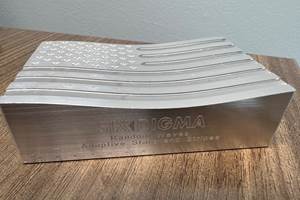“Turning” the Tables: 10 Must-Read Articles to Sharpen Your Lathe Game
From complex Swiss-type lathes to turning basics, we’ve rounded up 10 turning articles for both beginners and advanced machinists.
Share






Whether you're new to the world of turning or a seasoned machinist looking to tighten your tolerances, there are always more ideas to turn over in your mind. From mastering Swiss-type machines to considerations when buying a lathe, we’ve gathered 10 standout articles that cover turning basics and beyond. This list contains practical tips, expert advice and a look at emerging technologies — all designed to help you get the most out of your lathe operations.
Machining 101: What is Turning?

Turning uses a lathe to remove material from the outside of a rotating workpiece, while boring does the same from the inside of a rotating workpiece. Learn more in this article about the basics of turning.

This Swiss-type requires only 120 volts of power, basic compressed air supply, weighs in at 150 pounds and needs a table that’s just two by four feet. Learn more about this desktop lathe from APSX in this article.
Choosing Your Carbide Grade: A Guide

Without an international standard for designating carbide grades or application ranges, users must rely on relative judgments and background knowledge for success. In this article, we breakdown what constitutes a carbide grade and how each element influences different aspects of machining.

In this article, Vallorbs Jewel Company gives their suggestions on training employees on a Swiss-type lathe.
Second B-Axis Improves Efficiency of Swiss-Type Machining

In this article, learn how a highly stable, fully programmable B-axis on the subspindle of Nomura DS’s 20J3XBTC enables users to more quickly machine complex parts complete.

This technology uses a laser to act as a cutting tool to "turn" parts from solid barstock. This high-speed precision turning machine is especially useful for micromachining, enabling high accuracy for small, complex parts that are often delicate and difficult to machine when implementing conventional turning processes.
Buying a Lathe: The Basics
 Source: Getty Images
Source: Getty ImagesLathes represent some of the oldest machining technology, but it’s still helpful to remember the basics when considering the purchase of a new turning machine.

In the late 1800s, a new technology — Swiss-type machines — emerged to serve Switzerland’s growing watchmaking industry. Today, Swiss-machined parts are ubiquitous, and there’s a good reason for that: No other machining technology can produce tiny, complex components more efficiently or at higher quality.
How to Start a Swiss Machining Department From Scratch

When Shamrock Precision needed to cut production time of its bread-and-butter parts in half, it turned to a new type of machine tool and a new CAM system. Here’s how the company succeeded, despite the newness of it all.

There can be hidden issues using legacy cam-driven lathes that can be overcome using new CNC technology. Here are three to keep in mind.
Related Content
View From My Shop: The Challenge of a One-Man Machine Shop
Mason Montalvo took up the challenge of starting his own shop running manual machine tools to produce complex parts.
Read MoreMachine Tool Drawbar Made With Additive Manufacturing Saves DMG MORI 90% Lead Time and 67% CO2 Emission
A new production process for the multimetal drawbar replaces an outsourced plating step with directed energy deposition, performing this DED along with roughing, finishing and grinding on a single machine.
Read MoreBuilding Machines and Apprenticeships In-House: 5-Axis Live
Universal machines were the main draw of Grob’s 5-Axis Live — though the company’s apprenticeship and support proved equally impressive.
Read MoreSoft Skills Prove a Sharp Edge in Plastics Manufacturing
East Coast Precision Manufacturing’s uncommon specialties attract many customers — but its prompt, earnest communication strategy is what wins it repeat business.
Read MoreRead Next
AMRs Are Moving Into Manufacturing: Considerations for Implementation
AMRs can provide a flexible, easy-to-use automation platform so long as manufacturers choose a suitable task and prepare their facilities.
Read More2025 Top Shops Benchmarking Survey Now Open Through April 30
91╩ËĂÁ═°Ňż╬█'s Top Shops Benchmarking Survey is now open, offering metalworking and machining operations actionable feedback across several shopfloor and business metrics.
Read MoreDigital Twin Provides Real-Time Feedback on Part Quality
By gathering data directly from the sensors of the CNC machine, the digital twin offered by Gemineering can identify whether a part is in tolerance and even identify the moment in the toolpath when a part fails to achieve tolerance.
Read More


















